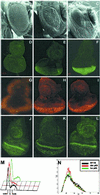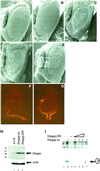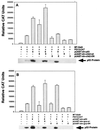Chk2 regulates irradiation-induced, p53-mediated apoptosis in Drosophila
- PMID: 12172011
- PMCID: PMC123252
- DOI: 10.1073/pnas.172382899
Chk2 regulates irradiation-induced, p53-mediated apoptosis in Drosophila
Abstract
The tumor suppressor function of p53 has been attributed to its ability to regulate apoptosis and the cell cycle. In mammals, DNA damage, aberrant growth signals, chemotherapeutic agents, and UV irradiation activate p53, a process that is regulated by several posttranslational modifications. In Drosophila melanogaster, however, the regulation modes of p53 are still unknown. Overexpression of D. melanogaster p53 (Dmp53) in the eye induced apoptosis, resulting in a small eye phenotype. This phenotype was markedly enhanced by coexpression with D. melanogaster Chk2 (DmChk2) and was almost fully rescued by coexpression with a dominant-negative (DN), kinase-dead form of DmChk2. DN DmChk2 also inhibited Dmp53-mediated apoptosis in response to DNA damage, whereas overexpression of Grapes (Grp), the Drosophila Chk1-homolog, and its DN mutant had no effect on Dmp53-induced phenotypes. DmChk2 also activated the Dmp53 transactivation activity in cultured cells. Mutagenesis of Dmp53 amino terminal Ser residues revealed that Ser-4 is critical for its responsiveness toward DmChk2. DmChk2 activates the apoptotic activity of Dmp53 and Ser-4 is required for this effect. Contrary to results in mammals, Grapes, the Drosophila Chk1-homolog, is not involved in regulating Dmp53. Chk2 may be the ancestral regulator of p53 function.
Figures






Similar articles
-
Drosophila Chk2 and p53 proteins induce stage-specific cell death independently during oogenesis.Apoptosis. 2010 Dec;15(12):1425-34. doi: 10.1007/s10495-010-0539-z. Apoptosis. 2010. PMID: 20838898 Free PMC article.
-
Drosophila melanogaster MNK/Chk2 and p53 regulate multiple DNA repair and apoptotic pathways following DNA damage.Mol Cell Biol. 2004 Feb;24(3):1219-31. doi: 10.1128/MCB.24.3.1219-1231.2004. Mol Cell Biol. 2004. PMID: 14729967 Free PMC article.
-
Drosophila p53 is a structural and functional homolog of the tumor suppressor p53.Cell. 2000 Mar 31;101(1):91-101. doi: 10.1016/S0092-8674(00)80626-1. Cell. 2000. PMID: 10778859
-
Guardian ancestry: fly p53 and damage-inducible apoptosis.Cell Death Differ. 2000 Nov;7(11):1035-8. doi: 10.1038/sj.cdd.4400766. Cell Death Differ. 2000. PMID: 11139275 Review.
-
The p53 control of apoptosis and proliferation: lessons from Drosophila.Apoptosis. 2014 Oct;19(10):1421-9. doi: 10.1007/s10495-014-1035-7. Apoptosis. 2014. PMID: 25217223 Free PMC article. Review.
Cited by
-
Distinct p53 isoforms code for opposing transcriptional outcomes.Dev Cell. 2022 Aug 8;57(15):1833-1846.e6. doi: 10.1016/j.devcel.2022.06.015. Epub 2022 Jul 11. Dev Cell. 2022. PMID: 35820415 Free PMC article.
-
dRTEL1 is essential for the maintenance of Drosophila male germline stem cells.PLoS Genet. 2021 Oct 13;17(10):e1009834. doi: 10.1371/journal.pgen.1009834. eCollection 2021 Oct. PLoS Genet. 2021. PMID: 34644293 Free PMC article.
-
Phylogeny and function of the invertebrate p53 superfamily.Cold Spring Harb Perspect Biol. 2010 Jul;2(7):a001131. doi: 10.1101/cshperspect.a001131. Epub 2010 May 5. Cold Spring Harb Perspect Biol. 2010. PMID: 20595397 Free PMC article. Review.
-
Modification of Drosophila p53 by SUMO modulates its transactivation and pro-apoptotic functions.J Biol Chem. 2008 Jul 25;283(30):20848-56. doi: 10.1074/jbc.M710186200. Epub 2008 May 20. J Biol Chem. 2008. PMID: 18492669 Free PMC article.
-
Contributions of DNA repair, cell cycle checkpoints and cell death to suppressing the DNA damage-induced tumorigenic behavior of Drosophila epithelial cells.Oncogene. 2015 Feb 19;34(8):978-85. doi: 10.1038/onc.2014.42. Epub 2014 Mar 17. Oncogene. 2015. PMID: 24632609
References
Publication types
MeSH terms
Substances
LinkOut - more resources
Full Text Sources
Other Literature Sources
Molecular Biology Databases
Research Materials
Miscellaneous

